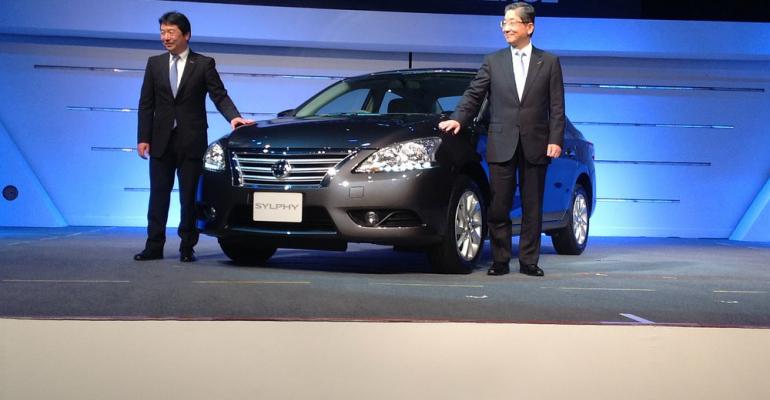BANGKOK – Thailand will serve as a base for what Nissan believes is one of its most historically significant cars, the new Sylphy now entering the market here.
Thailand is the second country to get the global sedan following China, and it also will serve as the first export hub for the C-segment model.
Cars will begin to be shipped from here to markets throughout the Association of Southeast Asian Nations free-trade region, Oceania and the Middle East by the end of the year, part of a rollout that eventually will take the Sylphy to about 120 countries.
Thailand’s hotly contested C-segment long has been the preserve of Toyota and Honda. However, the game is changing rapidly. The Chevrolet Cruze already has broken the stranglehold to carve out its own niche, and Ford’s newly arrived Focus could prove competitive, as well.
Nissan launches the Sylphy from a strong position here. Its March eco-car family, which now includes the Almera sedan derivative, has just broken through the 100,000-unit sales barrier in Thailand, giving the line control of well over half of the eco segment, and Nissan officials are upbeat about similar prospects for the Sylphy.
“Nissan has been progressing positively,” Nissan Thailand President Takayuki Kimura says at the car’s recent launch. “We will reach double-digit growth in 2012 and (sell) 120,000 (vehicles overall).”
Through July, Nissan deliveries were up 40.2% year-on-year here, to 59,875 units.
Kimura says the auto maker will begin to introduce two vehicles a year, which will add up to “10 new models by 2016, (when) we will achieve a 15% market share.”
Last year, Nissan controlled 9.2% of Thai new-vehicle sales, up from 7.4% in 2010.
The rosy picture has seen the Japanese auto maker revise its “Power Up” plan in relation to this market, including adding more retail outlets. The auto maker will increase dealerships from 171 today to 191 by the end of the year and 210 by 2016, Kimura says.
“Our business in Thailand is vital not only for local needs but is a strategic global hub,” he says. “In Thailand, we have increased domestic production 50%, we have increased our own internal production lines and we achieve Nissan Japan's highest (quality) standards.”
“Thailand is recording high growth, (and) it's good to see the government involved in growth,” adds Nissan Chief Operating Officer Toshiyuki Shiga, pointing to the Sylphy’s inclusion in the government’s first-time buyer incentive.
Shiga sees Power Up Thailand focusing on three areas: further penetration of the eco-car sector, improvements in the retail network and increased sales volumes.
“I am confident this will contribute to achieving our goals and more than doubling market share,” he says.
The Sylphy kicks off here with some momentum, following its successful debut at the Beijing auto show. “Sylphy has already hit 18,000 sales (in China), and I expect it to be a big success here,” Shiga says.
The fiscal-year (to March 2013) sales target for Thailand is 20,000 units, with some of this volume coming as a result of the first-time buyer scheme, probably about 10%.
Overall market demand also should help propel sales. The minimum-wage increase has helped spur sales, Nissan officials note, and they now project industry volume of 1.2 million vehicles here in 2012.
Sylphy exports will commence around December and should reach 20,000 units by March 2013.
That will provide a decent chunk of the “confirmed target” 260,000 vehicles Nissan plans to produce here this year, a figure that edges close to total available capacity of 280,000 units. Of the total, 120,000 vehicles are earmarked for domestic sale and 140,000 for export.
The numbers include the Navara pickup, built locally by Mitsubishi. It has a 40,000-unit first-year target, as the project has come up to speed more slowly than expected. Its second year goal is a full-capacity 60,000 units.
The 2012 projections represent a sharp jump from 2011, when Nissan produced 191,000 vehicles in Thailand, with exports accounting for 115,000 units.
The Thai-built Sylphy will be powered by the same 1.6L and 1.8L engines the Chinese version uses, along with 5-speed manual or continuously variable transmission.
Features include light-emitting-diode lamps both front and rear and rear backup camera. It offers a choice of six colors and is priced from 746,000-931,000 baht ($23,800-$29,700). A second body style is in the pipeline.
Asked if other models in addition to the March will be shipped from here to Japan in the future, Shiga says: "Yes of course. There is no disadvantage in shipping from Thailand to Japan; there is opportunity.”
Additional investment will be made in Thailand to cope with the production ramp-up, but Nissan isn't saying whether it will expand existing plants or build new ones. The auto maker also is keenly interested in the debate under way here over vehicle-tax structure, and favors a carbon-dioxide-emissions based system.
No decision has been taken yet on whether to bring the re-launched Datsun brand back to Thailand. It will be going to ASEAN’s most populated country, Indonesia, as well as India and Russia.
“Many markets are interesting to the Datsun brand,” Shiga says. “For (the) Thailand market, we will study, but we’ve not yet decided.”





